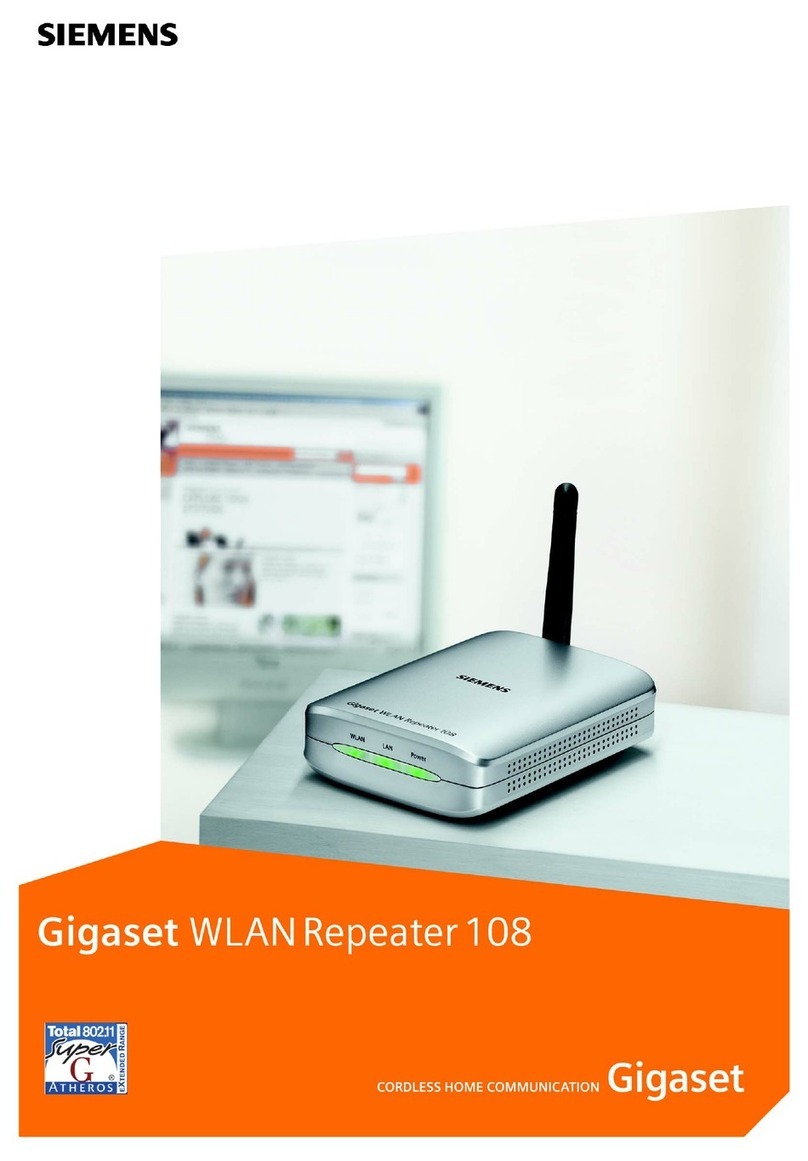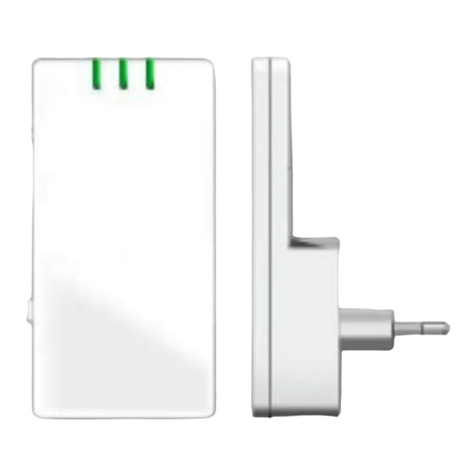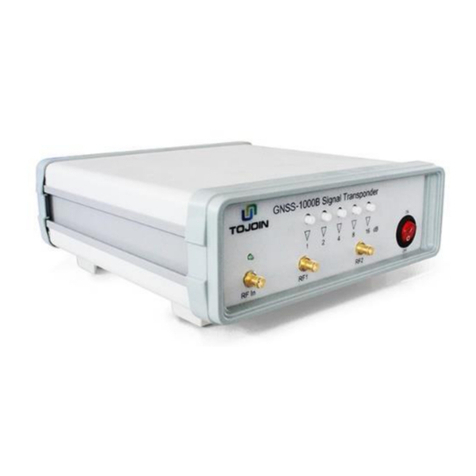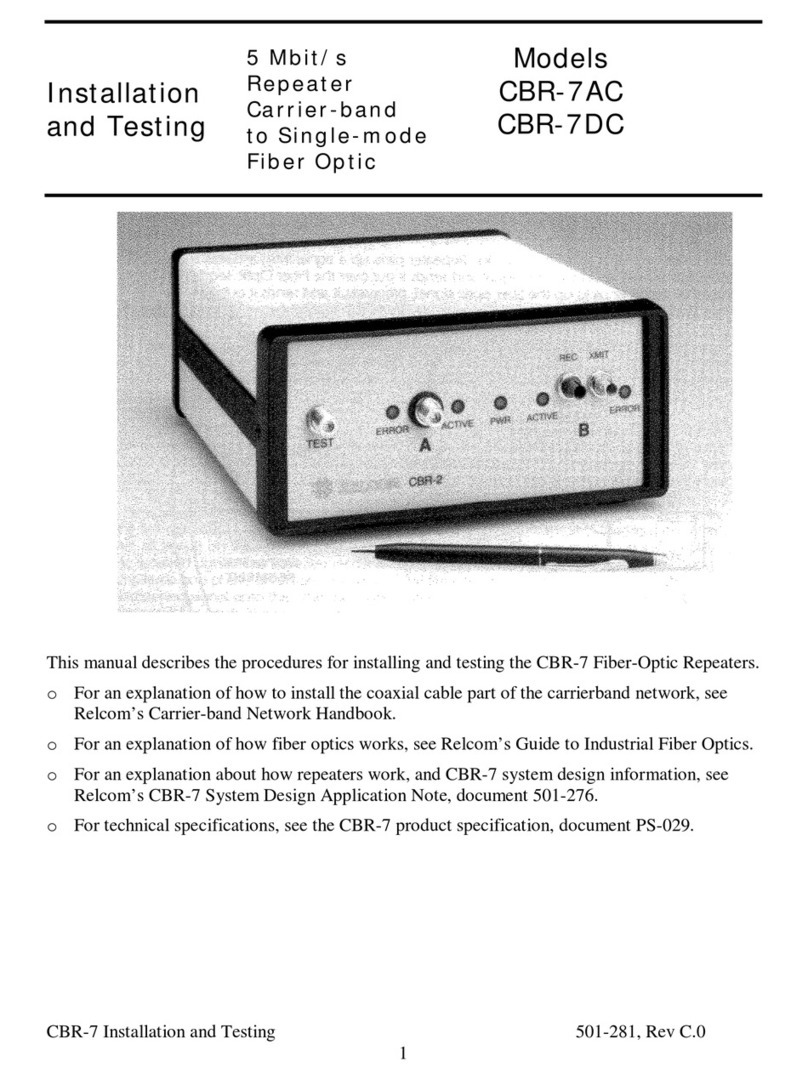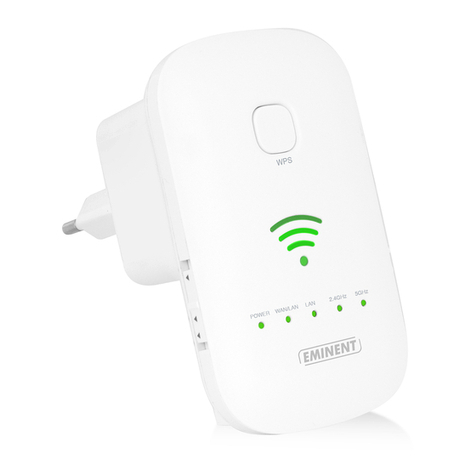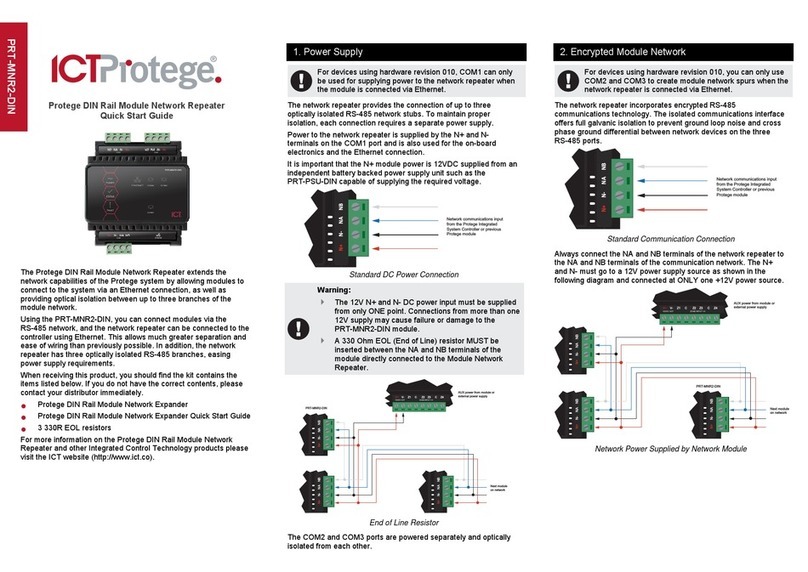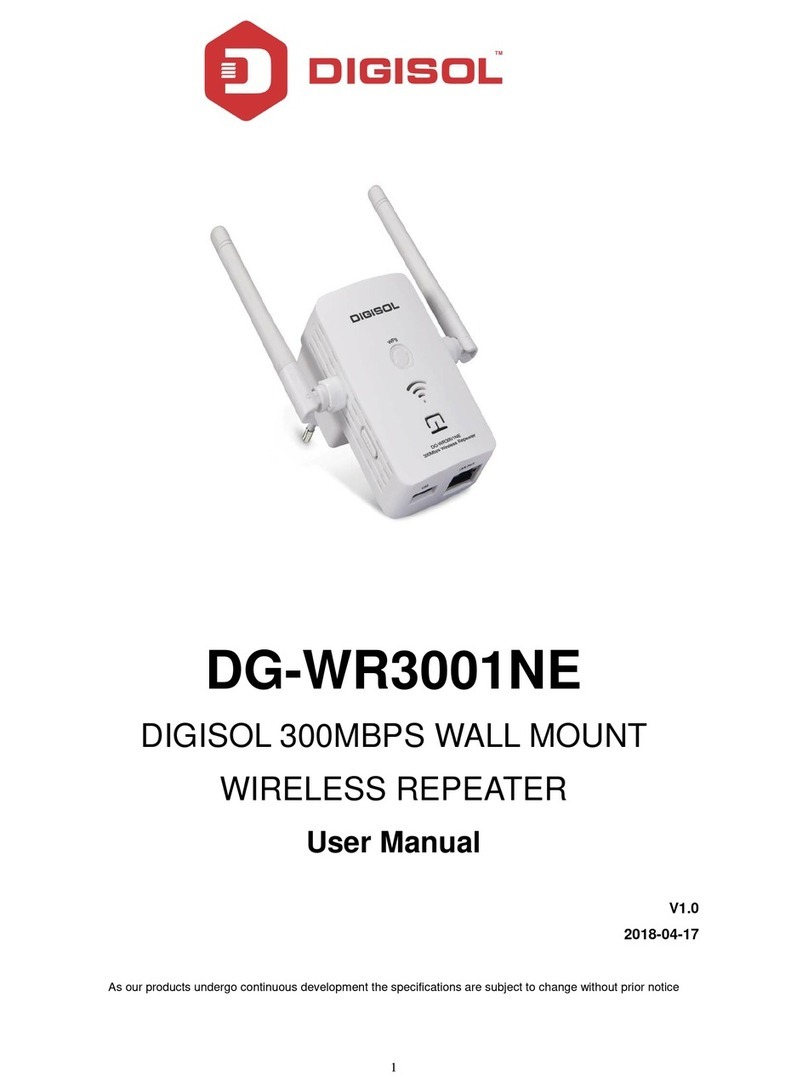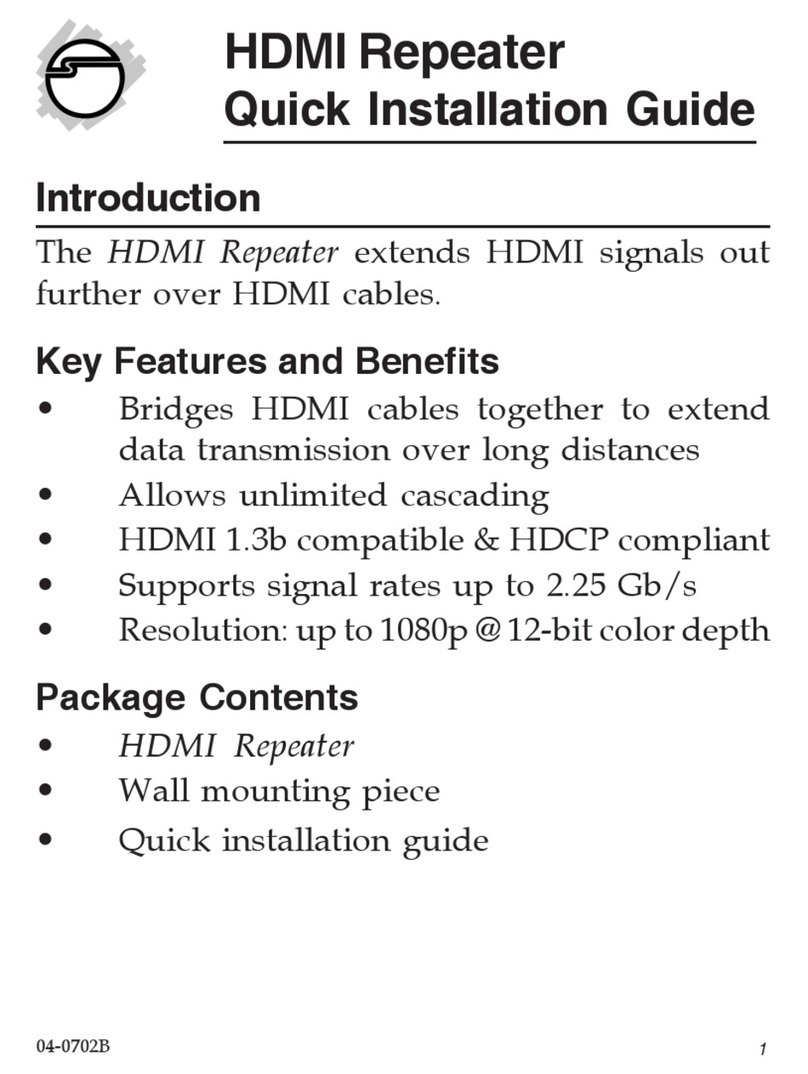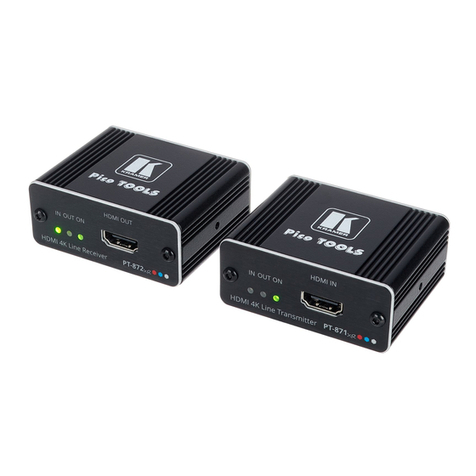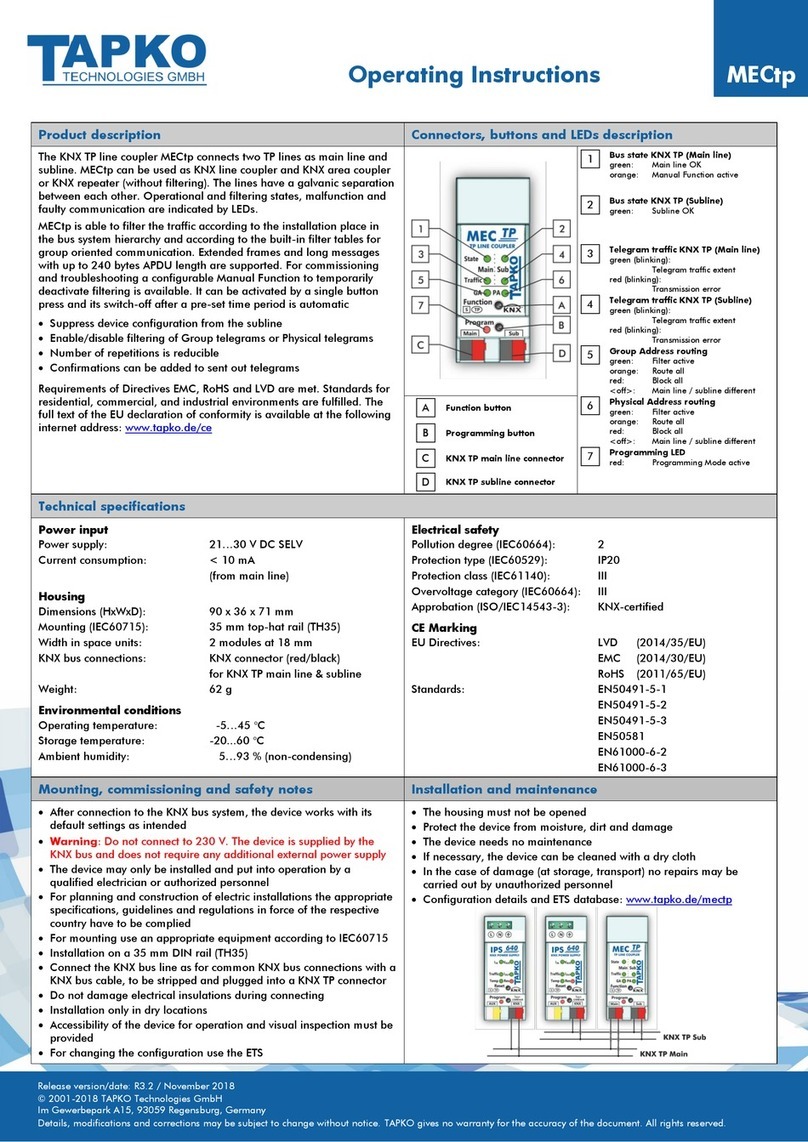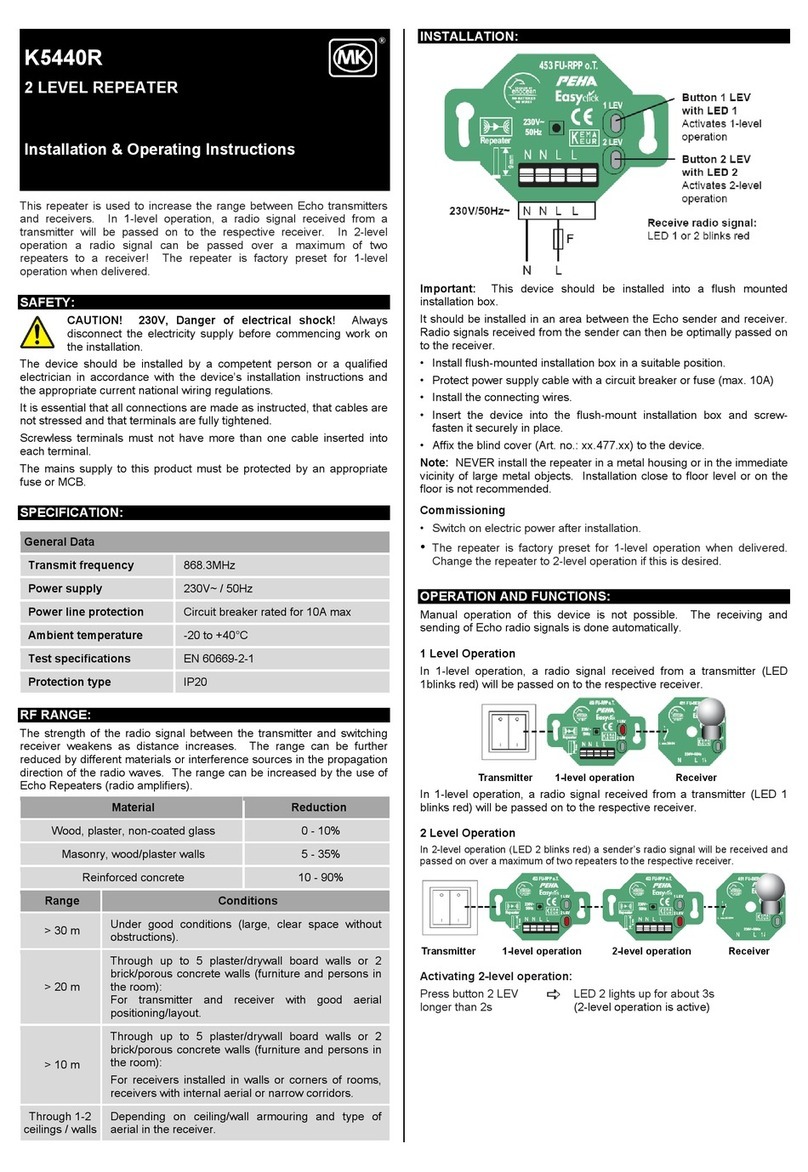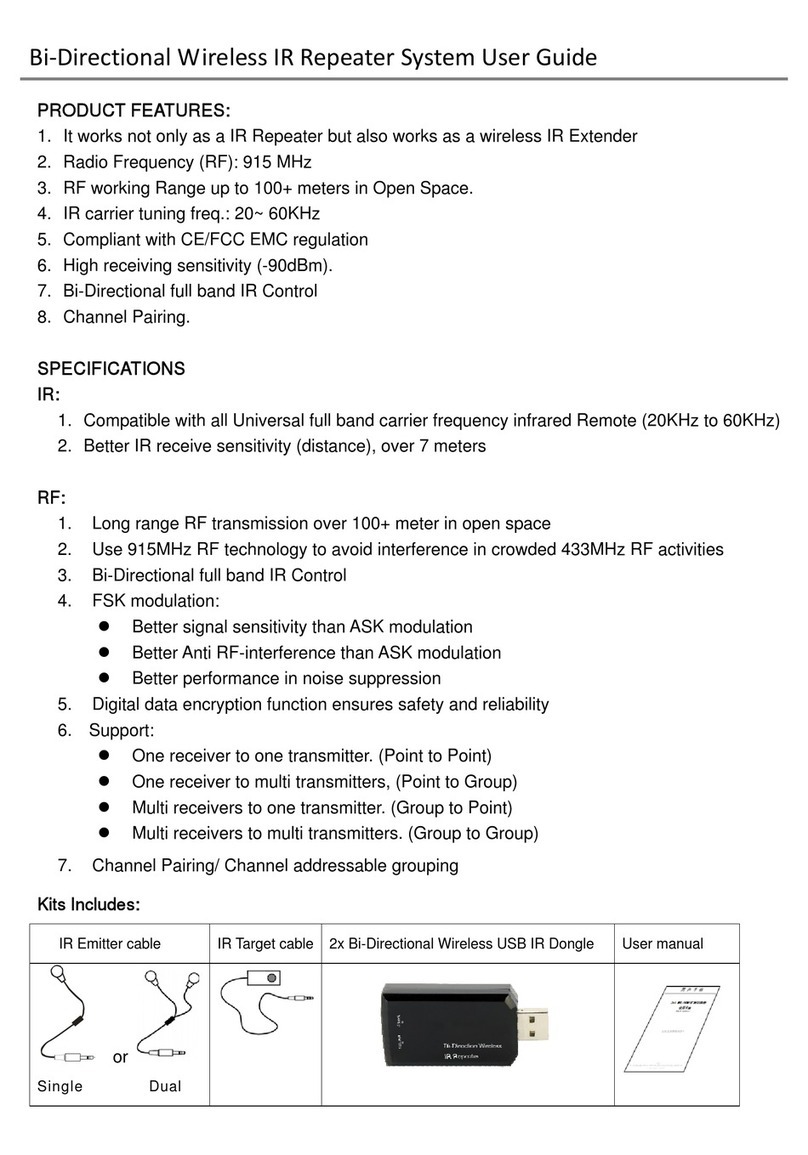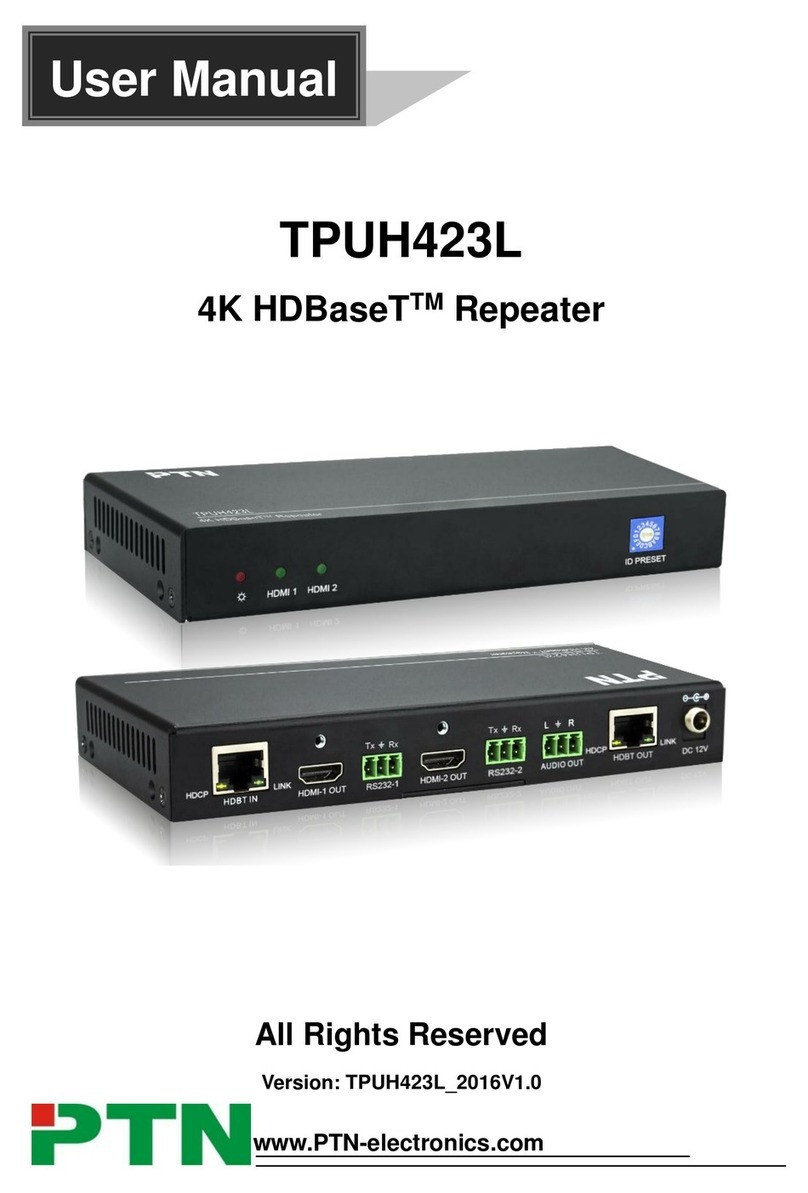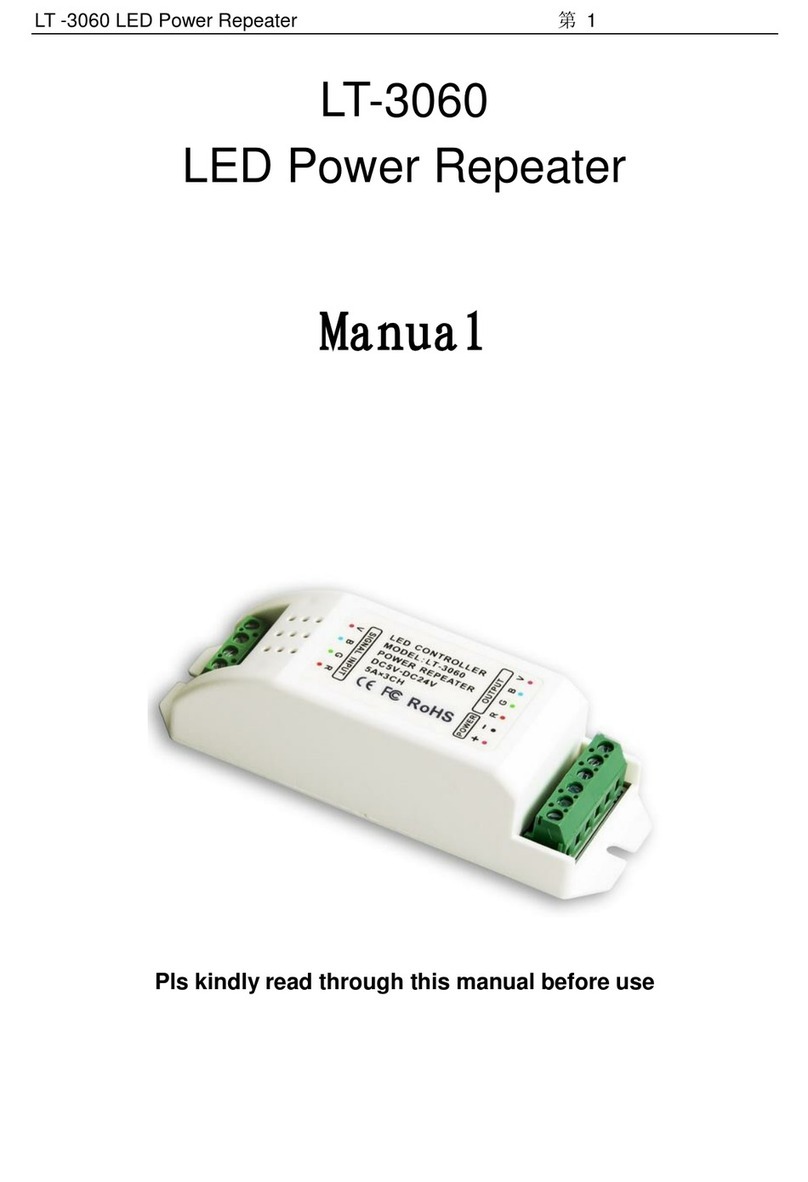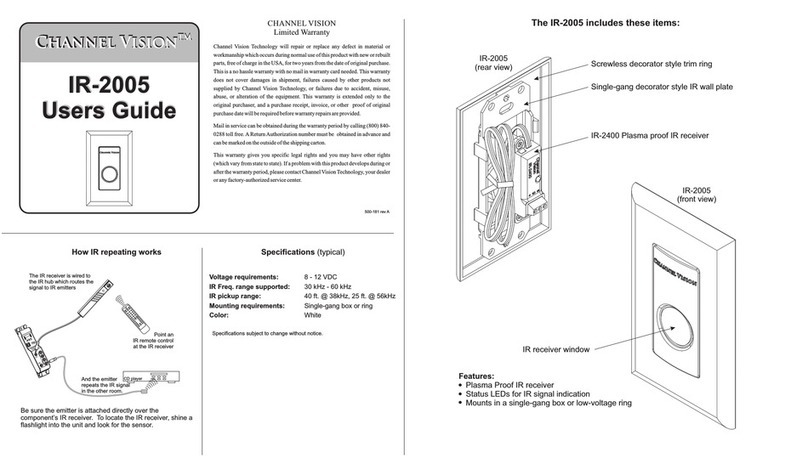SmarTrunk Systems ST-9116C User manual

UHF FM DIGITAL REPEATER
ST-9116C (400Mhz ~ 470Mhz)
SERVICE MANUAL
SmarTrunk Systems, INC.
ST-9116C SM R1.1

ST-9116C SM R 1.1 SMARTRUNK SYSTEMS, INC.
2
Contents
1. SPECIFICATIONS: ...................................................................................................................5
2. ST-9116 EXPLODED VIEW......................................................................................................6
3. ST-9116C SIMPLIFIED DIAGRAM ...........................................................................................7
4. - ST-9116C RF DESCRIPTION.................................................................................................... 8
4.1. CIRCUIT CONFIGURATION..................................................................................................... 8
4.2. RECEIVER SYSTEM .................................................................................................................8
4.2.1. FRONT-END RF RECEIVER......................................................................................................8
4.2.2. ANALOG AUDIO PROCESSING ...............................................................................................8
4.2.3. VIRTUAL SQUELCH CIRCUIT...................................................................................................9
4.2.4. VIRTUAL VOLUME CONTROL.................................................................................................9
4.2.5. SUB AUDIO SIGNALING ......................................................................................................... 9
4.2.6. ANALOG AUDIBLE SIGNALING............................................................................................... 9
4.2.7. DIGITAL AUDIO PROCESSING ..............................................................................................10
4.3. TRANSMITTER SYSTEM ....................................................................................................... 10
4.3.1. ANALOG TX SIGNAL FROM EXTERNAL MIC......................................................................... 10
4.3.2. ANALOG REPEATER LOOP ...................................................................................................11
4.3.3. DIGITAL TX AUDIO FROM EXTERNAL MIC:.......................................................................... 11
4.3.4. REPEATER DIGITAL TX AUDIO: ............................................................................................ 12
4.3.5. DRIVE AND FINAL AMPLIFIER STAGES.................................................................................12
4.3.6. AUTOMATIC TRANSMIT POWER CONTROL ........................................................................13
5. ST-9116 ALIGNMENT...........................................................................................................14
5.1. INTRODUCTION...................................................................................................................14
5.2. ALIGNMENT:........................................................................................................................14
5.3. REQUIRED TEST EQUIPMENT ..............................................................................................15
5.4. ALIGNMENT PROCEDURE....................................................................................................15
5.4.1. GENERAL ALIGNMENT CONSIDERATIONS:..........................................................................15
5.5. MAIN REPEATER ALIGNMENT .............................................................................................16
5.6. TRANSMITTER ALIGNMENT: ...............................................................................................16
5.6.1. TX CLOCK ALIGNMENT: .......................................................................................................17
5.6.2. TRANSMIT POWER ALIGNMENT: ........................................................................................17

ST-9116C SM R 1.1 SMARTRUNK SYSTEMS, INC.
3
5.6.2.1. HIGH POWER LEVEL ALIGNMENT........................................................................................18
5.6.2.2. MID POWER LEVEL ALIGNMENT .........................................................................................19
5.6.2.3. LOW POWER LEVEL ALIGNMENT ........................................................................................19
5.6.3. ANALOG MAXIMUM DEVIATION FOR NARROW BAND ......................................................19
5.6.4. ANALOG MAXIMUM DEVIATION FOR WIDE BAND.............................................................20
5.6.5. FDMA DATA MODULATION ALIGNMENT:........................................................................... 20
5.6.6. TDMA DATA MODULATION ALIGNMENT: ..........................................................................21
5.6.7. SMARTRUNK II DEV ALIGNMENT (NARROWBAND):...........................................................21
5.6.8. SMARTRUNK II DEV ALIGNMENT (WIDE BAND): ................................................................22
5.6.9. EIA TONES LEVEL ALIGNMENT (NARROWBAND):...............................................................22
5.6.10. EIA TONES LEVEL ALIGNMENT (WIDE BAND): .................................................................... 23
5.6.11. DTMF SIGNALING LEVEL ALIGNMENT FOR NARROW BAND CHANNELS: ...........................23
5.6.12. DTMF SIGNALING LEVEL ALIGNMENT FOR WIDE BAND CHANNELS: .................................24
5.6.13. DCS SIGNALING ALIGNMENT FOR NARROW BAND CHANNELS:......................................... 25
5.6.14. DCS SIGNALING ALIGNMENT FOR WIDE BAND CHANNELS: ...............................................25
5.6.15. CTCSS SIGNALING ALIGNMENT FOR NARROW BAND CHANNELS ......................................26
5.6.16. CTCSS SIGNALING ALIGNMENT FOR WIDE BAND CHANNELS.............................................26
5.6.17. FSK SIGNALING ALIGNMENT FOR NARROW BAND CHANNELS: .........................................27
5.6.18. FSK SIGNALING ALIGNMENT FOR WIDE BAND CHANNELS:................................................27
5.6.19. RX CLOCK ALIGNMENT:.......................................................................................................28
5.7. RECEIVER ALIGNMENT ........................................................................................................30
5.7.1. ANALOG DISCRIMINATOR GAIN..........................................................................................30
5.7.2. FDMA DISCRIMINATOR GAIN..............................................................................................30
5.7.3. TDMA DISCRIMINATOR GAIN..............................................................................................31
5.7.4. ANALOG ROAMING GAIN.................................................................................................... 32
5.7.5. VOCODER OUT GAIN........................................................................................................... 32
5.7.6. VOCODER IN GAIN...............................................................................................................33
6. COMPLIMENTARY USER ALIGNMENT .................................................................................34
6.1. TEMPERATURE CONTROL: ..................................................................................................34
6.2. FAN CONTROL: ....................................................................................................................34
7. ST-9116C MAIN BOARD SCHEMATIC ..................................................................................37

ST-9116C SM R 1.1 SMARTRUNK SYSTEMS, INC.
4
8. ST-9116 FRONT BOARD SCHEMATIC............................................................................................... 38
9. COMPONENT LOCATOR .............................................................................................................. 39
9.1. ST-9116 COMPONENT LOCATOR (TOP LAYER) ...........................................................................39
9.2. ST-9116C COMPONENT LOCATOR (BOTTOM LAYER) .................................................................40
10. MAIN PCB LAYOUT...................................................................................................................... 41
10.1. MAIN PCB –TOP LAYER...............................................................................................................41
10.2. MAIN PCB –BOTTOM LAYER ......................................................................................................42
10.3. MAIN PCB –POWER LAYER......................................................................................................... 43
10.4. MAIN PCB –GROUND LAYER ......................................................................................................44
11. ST-9116 FRONT BOARD COMPONENT LOCATOR........................................................................45
12. ST-9116 FRONT BOARD LAYOUT.................................................................................................46
13. ST-9116 BOM ..............................................................................................................................47
13.1. ST-9116C MAIN PCB BOM........................................................................................................... 47
13.2. ST-9116C FRONT PANEL ASSEMBLY BOM................................................................................... 61
14. EXTERNAL CONNECTIONS........................................................................................................... 62
14.1. ACCESSORY PORT:.......................................................................................................................63
14.2. USB: USB 2.0 COMPLIANCE......................................................................................................... 63
14.3. EXTERNAL MIC CONNECTOR PIN OUT .......................................................................................64
14.4. SD CARD SOCKET......................................................................................................................... 65
15. List of Figures: .............................................................................................................................66

1. SPECIFICATIONS:
SPECIFICATION
UHF
GENERAL
Frequency Range
400 TO 470 [Mhz]
Channels
64
Digital Protocol
Digital FMDA / TDMA / ANALOG / HIBRID
IP Interface
TCP/UDP IEEE 802.3
Power
12 ~ 15 Vdc
Dimensions
90 (h) x 482.6 (w) x 173.1 (d) [mm] ; (3.5(h) x 19(w) x 5.65 (d)) (in)
Target Weight
2.4Kg (5.2lbs)
Temperature range
- 30 °C ~ 60 °C (-22°F ~ +140°F)
Signaling
51 CTCSS tones / 183 DCS tones / 65534 Express Fleet IDs
Display
COLOR TOUCH SCREEN TFT 480(W) × RGB × 272(H)
Microphone Connector
Yes
Power Saver control
Yes
TOT
Yes
Adjustable Power Selection
Auto + H/M/L
Adjustable Squelch Level
Analog
Password
Yes
Voice encryption
Voice Inversion/Multiple hop rolling
Key Function selection
Yes
Mechanics
19-inch rack mount design
TRANSMIT
RF power
40W (25W CDC)
Frequency Stability
+/- 1PPM
Bandwidth
12.5Khz/25Khz
Spurious emissions
-60dBC (typ)
Adjacent Channel Power
-65dBC min
SNR
45dB typ
Analog harmonic distortion
3% typ (AF 1Khz, 40% deviation)
Data transmit rate
2400/4800/9600 bps
Microphone connector
RJ-45 (8pin)
Analog Max frequency deviation
2.5Khz (12.5Khz) / 5Khz (25 Khz)
Ext. Mic. Impedance
600Ohms
RECEIVER
Analog Sensitivity
0.25uV (12dB Sinad)
Digital Sensitivity
0.3uV (5% BER)
Squelch Sensitivity
0.3uV (Threshold)
Spurious response
60dB typ
image rejection
60dB typ
HUM and NOISE ratio
45dB
Speaker Audio Power
5W
Specifications subject to change without notice

2. ST-9116 EXPLODED VIEW

ST-9116C SM R 1.1 SMARTRUNK SYSTEMS, INC.
7
3. ST-9116C SIMPLIFIED DIAGRAM
Main Processor
[U37]
LPF Final AMP
U3
Power Detection
U1 Driver
Q2 Buffer
AMP
Q1
TX CTRL
[Q9 Q18]
TX Radio
U2
POWER CTRL
[U9] Audio Processor
TX Modem
[U20] TX VOCODER
[U21]
Audio Processor
RX Modem
[U35] RX VOCODER
[U22]
RX Radio
U8
LPF AMPLIFIER
Q10
FILTER
D12/D13 FILTER
D9/D11
IP
[U39]
A
C
C
[P1]
DISPLAY
AUDIO PA
[U36]
Sqelch
[R123]
Volume
[R131]
MIC
[J6]
FLASH
MEMORY
[U30]
RAM MEMORY
[U23]
PWM
SD Card
[U33]
CLOCK
[Y1]
[U41]
CLOCK
[Y3]
CLOCK
[Y4]
CLOCK
[Y2]
Filter
CTRL
[U10]
USB
[J8]

4. - ST-9116C RF DESCRIPTION
4.1. CIRCUIT CONFIGURATION
The receiver is a single receiver with
built DSP fully integrated.
Incoming signals from the antenna,
after passing through LPF filter, are
band limited by an active bandpass
filter then fed direct to the DSP
down converter to get the baseband
voice from 0Hz to 3500Hz.
Demodulated signals are filtered
and conditioned onto a second DSP
based filter, which also includes a
high efficiency 4FSK modem.
For digital demodulation, the
recovered data is fed into a vocoder,
which converts the data to voice.
Analog voice from the analog path
or the analog voice recovered from
the vocoder, are fed into an audio
power amplifier.
The transmit signal frequency is
generated by the integrated VCO
and PLL. RF frequency generated by
the integrated RF chip is amplified
into a 3-step amplifier then filtered
by a low pass filter to be applied to
the antenna.
4.2. RECEIVER SYSTEM
4.2.1. FRONT-END RF RECEIVER
Incoming RF signals from the RX
antenna are delivered to the
Receiver Unit and passing through
an active band pass filter.
D12 & D13 varicaps works with D9
& D11 as a tuned filter controlled
by U10.
In the middle of the filter chain. An
amplifier compensates the loss
introduced by the filter. The gain of
Q10, the amplifier, can be adjusted
to increase the overall RX gain up
to 10dB.
ST-9116 firmware adjusts the gain
of this amplifier to ensure the best
signal to noise relationship.
4.2.2. ANALOG AUDIO PROCESSING
The RF signal is tuned by U8, which
includes a base band DSP audio
processing, recovering flat audio
from DC up to 3500 hz.
Figure 1: Receiver block Diagram
Figure 2: Receiver Analog Audio Path Bloc Diagram
RX
Radio
U8
LPF
AMPLIFIER
Q10
FILTER
D12/D13
FILTER
D9/D11
Filter
CTRL
[U10]
Band pass control
Gain control
Main Processor
[U37]
RX Radio
U8
AUDIO
PA
[U36]
PWM
FILTER
Analog
Loop
Audio
Processor
RX Modem
[U35]

ST-9116C SM R 1.1 SMARTRUNK SYSTEMS, INC.
9
The detected audio is amplified,
filtered and conditioned inside of
U35 which also includes a de-
emphasize filtering for received
audio signals.
The output of the filtered and
conditioned audio is fed into one
ADC converter of the main
processor where it is converted to
PCM audio to be processed and
switched as per application
requirement.
One independent analog filtered
output is fed direct to transmit
audio processor for analog repeater
mode.
4.2.3. VIRTUAL SQUELCH CIRCUIT
RSSI is measured by the receiver
(U8) as the result of the analysis of
the signal and the noise of the
carrier. The output is sent to the
main processor (U37) as a digital
frame, which is analyzed by
repeater firmware.
In other way, R123 potentiometer
position is read by one ADC input
on the RX Audio Processor (U35)
the value between -132dBm and -
30dBm is calculated in agree to the
potentiometer angle.
If the RSSI is higher than the
expected value of squelch threshold
calculated and the monitor function
is enabled working in analog mode,
then the speaker is unmuted and
the PWM incoming audio (PCM) is
delivered to the PWM filter to be
integrated then it is fed to the
amplifier.
4.2.4. VIRTUAL VOLUME CONTROL
The PCM audio can be sent to the
speaker in case of monitoring is
required. On this case, the
processor generates a PWM audio,
which is filtered then delivered to
the audio Power Amplifier (U36).
Monitor audio volume control is
based on the reading of the volume
potentiometer (R131) by one of the
ADC inputs of the RX Audio
Processor (U35) then the value is
sent to the main processor through
the SPI bus.
Main Processor (U37) adjusts the
PWM level in agree to the desired
audio level.
4.2.5. SUB AUDIO SIGNALING
Received sub audio signaling as
CTCSS and DCS are received and
processed by the receiver (U8) then
detected on the audio processor
(U35). Once decoded, the sub audio
signaling is reported to the
processor where the firmware
compares it with the programmed
into the current channel
programming.
If the received signaling matches
the channel programming, then the
main processor (U37) requests the
audio processor (U35) to enables
the analog repeater mode
4.2.6. ANALOG AUDIBLE SIGNALING
DTMF signals, MDC1200 and tone
signals are processed and decoded

ST-9116C SM R 1.1 SMARTRUNK SYSTEMS, INC.
10
by the audio processor (U35).
Decoded information or received
tone is reported to the main
processor (U37).
4.2.7. DIGITAL AUDIO PROCESSING
Digital received information is
processed by the receiver DSP (U8)
then delivered to the audio
processor (U35), which includes a
high-speed modem.
Data decoded by the modem is
transferred to the main processor
(U37) which de-encrypts the
information, checks the integrity,
correct the wrong bits and extract
the audio information form the
received frame.
The portion of the data received,
error free, is moved to the RX
vocoder (U21).
The vocoder re-builds the audio
from the compressed data then
applies filters it, adjust the volume
and fed it back to the processor
(U37) where the analog signal is
sampled with AdPCM format,
filtered and processed to be
delivered to the PWM filter then to
the audio amplifier (U36). AdPCM
audio frames are also sent to the IP
port when the repeater is working
on wide area environments.
4.3. TRANSMITTER SYSTEM
4.3.1. ANALOG TX SIGNAL FROM
EXTERNAL MIC
The Mic signal coming from the
front connector is conditioned on
Mic Amplifier (U43), which is an
active filter to make band limitation
and level adjustments.
The result of the conditioned and in
band-filtered signal is fed to the TX
Audio Processor (U20), which
provides audio compander,
emphasize, limitation, encryption,
etc.
The high audio band of the signal
from 300 to 3500 Hz are directly fed
to the transmitter (U2), which
performs a direct modulation of a
generated carrier.
Low frequency signaling audio are
also fed directly to VC TXCO (Y1)
main clock generator and U2 with a
corresponding balance controlled
by software.
Figure 4: Analog Modulation path
Figure 3: Digital Receiver Audio Path Block Diagram
Main Processor
[U37]
Audio
Processor
RX Modem
[U35]
RX Radio
U8
AUDIO
PA
[U36]
PWM
FILTER
Vocoder
[U21]
AMPLIFIER
[U7]
AUDIO
PROCESSOR
[U12]
TRANSMITTER
[U2]
VC TXCO
[Y1]
Mic
Connector

ST-9116C SM R 1.1 SMARTRUNK SYSTEMS, INC.
11
4.3.2. ANALOG REPEATER LOOP
In repeater mode, the RF is detected
by the receiver front-end (U8) then
the discriminator audio is fed into
the receiver audio processor (U35)
to be conditioned and filtered.
The received audio is fed to
transmit audio processor (U20)
where the signal is emphasized and
limited to ensure the proper
transmission shape.
If sub audio signaling is required,
then it is also generated by transmit
audio processor (U20).
The result of the analog modulation
is divided in low band and high
band to be fed to the transmitter
(U2) and a fraction of the low band
information is modulated throw TX
VC TXCO (Y1).
4.3.3. DIGITAL TX AUDIO FROM
EXTERNAL MIC:
The Mic signal coming from the
front connector is fed into the
microphone pre-amplifier (U43) to
be conditioned.
The output of the conditioned mic
signal is fed into the RX audio
processor (U35) to be filtered, then
fed to one ADC of the main
processor (U37) where is converted
to AdPCM format.
If required, this signal is sent to the
IP port for wide area applications.
Once inside of the processor, the
PCM information is managed in
agree to the digital transmission
mode, being delivered to one of the
PWM filters related to any of the
vocoders, which may serve to the
digital transmission.
The output of the vocoder is
collected by the processor (U37)
where the data is encrypted in agree
to SDR protocol, adding a FEC
(Frame Error Correction), and
adding the user related information
as user ID, etc., arranging the
frames which are moved to the TX
modem (U20).
The output of the modem is fed into
the TX radio chip and a portion of
that modulation (low frequencies) is
fed to the VC-TXCO. The balance of
that information is controlled by the
TX audio processor, depending on
the modulation type required.
TX AUDIO
PROCESSOR
[U20]
TRANSMITTER
[U2]
VC TXCO
[Y1]
RX Radio
U8
RX AUDIO
PROCESSOR
[U35]
Figure 5: Analog Repeater loop path

ST-9116C SM R 1.1 SMARTRUNK SYSTEMS, INC.
12
4.3.4. REPEATER DIGITAL TX AUDIO:
Working on any digital modes, the
received carrier is detected by the
RX radio chip (U8), and then the
received audio in base band is fed
to the RX modem (U35).
RX modem recovers the received
data which is collected by the main
processor (U37), where is decrypted
and corrected from the received
FED.
The received data is routed as
required. In case of repeater mode,
a new frame is encoded, encrypted
and a new FEC is added, resulting
a new TX frame, which is fed into
the TX modem (U20).
The output of the modem is fed into
the TX radio chip and a portion of
that modulation (low frequencies) is
fed to the VC-TXCO. The balance of
that information is controlled by the
TX audio processor, depending on
the modulation type required.
4.3.5. DRIVE AND FINAL AMPLIFIER
STAGES
Transmit RF is amplified on Q1
(2SC5226) adjusting the
impedance, then filtered to be fed to
Q2 (2SC3357) then finally amplified
by U3 (RA60H1317) up to 50 watts
output power.
The transmit signal then passes
through forward and reflected
power bridge (U1) then it is low-
pass filtered to suppress harmonic
spurious radiation before delivery
to the antenna
Figure 6: Digital Modulation path from external mic
TX AUDIO
PROCESSOR
[U20]
TRANSMITTER
[U2]
VC TXCO
[Y1]
Main Processor
[U37]
Audio Processor
RX Modem
[U35]
Vocoder
[U21]
AMPLIFIER
[U43]
Mic
Connector
TX AUDIO
PROCESSOR
[U20]
TRANSMITTER
[U2]
VC TXCO
[Y1]
Main Processor
[U37]
Audio Processor
RX Modem
[U35]
RX Radio
U8
Figure 7: Repeater digital path

ST-9116C SM R 1.1 SMARTRUNK SYSTEMS, INC.
13
4.3.6. AUTOMATIC TRANSMIT POWER
CONTROL
The RF power detector (U1) detects
transmitted feedback and reverse
power feedback, and then the
detected signals are send to power
control stage (U9) to be compared
with the referenced power control
coming from TX audio processor
(U20). The reference power level are
set by the main processor (U37) to
the audio processor (U20) in agree
to the current channel information
stored into the memory.
Power control stage (U9) also
compares the reverse power
feedback coming from power meter
bridge (U1) to protect the power
module in case of antenna
mismatching.
The output of the power control
stage (U9) is fed direct to the RF
power Amplifier (U3) controlling the
DC bias input of the hybrid module.
Evenly when power level is adjusted
by software on three levels (Hi, Med,
Lo) the power value can be adjusted
to any desired value between zero
and 50Watts by the alignment
software.

ST-9116C SM R 1.1 SMARTRUNK SYSTEMS, INC.
14
5. ST-9116 ALIGNMENT
5.1. INTRODUCTION
The ST-9116 series are carefully
aligned at the factory for the
specified performance across the
frequency range depending for each
version. Realignment should
therefore not be necessary except in
the event of a component failure, or
altering version type.
All component replacement and
service should be performed only by
an authorized SmarTrunk
representative, or the warranty
policy may be void.
The following procedures cover the
sometimes critical and tedious
adjustments that are not normally
required once the repeater has left
the factory.
However, if damage occurs and
some parts subsequently are
placed, realignment may be
required. If a sudden problem
occurs during normal operation, it
is likely due to component failure;
realignment should not be done
until after the faulty component has
been replaced.
We recommend that servicing be
performed only by authorized
SmarTrunk service technicians
who are experienced with the
circuitry and fully equipped for
repair and align. Therefore, if a fault
is suspected, contact the dealer
from whom the transceiver was
purchased for instructions
regarding repair. Authorized
Smartrunk service technicians
realign all circuits and make
complete performance checks to
ensure compliance with factory
specifications after replacing any
faulty components.
Those who do undertake any of the
following alignments are cautioned
to proceed at their own risk.
Problems caused by unauthorized
attempts at realignment are not
covered by the warranty policy.
In addition, SmarTrunk reserves
the right to change circuits and
alignment procedures in the
interest of improved performance,
without notifying owners.
Under no circumstances should
any alignment be attempted unless
the normal function and operation
of the transceiver are clearly
understood, the cause of the
malfunction has been clearly
pinpointed and any faulty
components replaced, and
realignment determined to be
necessary.
5.2. ALIGNMENT:
The following test equipment (and
thorough familiarity with its correct
use) is necessary for complete
realignment. Correction of
problems caused by misalignment
resulting from use of improper test
equipment is not covered under the
warranty policy.
While most steps do not require all
of the equipment listed, the
interactions of some adjustments
may require that complex
adjustments be performed
afterwards. Do not attempt to
perform only a single step unless it

ST-9116C SM R 1.1 SMARTRUNK SYSTEMS, INC.
15
is clearly isolated electrically from
all other steps. Have all test
equipment ready before beginning,
and follow all of the steps in a
section in the order presented.
5.3. REQUIRED TEST EQUIPMENT
RF Signal Generator with
calibrated output level at 1
GHz
Deviation Meter (linear
detector)
In-line Wattmeter with 5 %
accuracy at 1 GHz
50 Ohm RF Dummy Load
with power rating 10W at 1
GHz
8 Ohm AF Dummy Load
(Attention: Audio output is
BTL output)
Regulated DC Power Supply
(standard 13.8 V DC, 15 A)
Frequency Counter with 0.2
ppm accuracy at 1GHz
Audio Generator
AC Voltmeter
DC Voltmeter
UHF Sampling Coupler
IBM PC / compatible
Computer with Microsoft®
Windows® XP or later
operating system
SmarTrunk SDRe
Programming software
(version 1.0 or later)
USB A/B Programming Cable
5.4. ALIGNMENT PROCEDURE
Alignment Preparation &
Precautions
A 50-Ohm RF Dummy Load and in-
line wattmeter must be connected
to the TX antenna jack in all
procedures that request for
transmission, except where
specified otherwise. Correct
alignment is not possible with an
antenna.
After completing one-step, read the
following step to determine whether
the same test equipment will be
required. If not, remove the test
equipment (except dummy load and
wattmeter, if connected) before
proceeding.
Correct alignment requires that the
ambient temperature be the same
as that of the repeater and test
equipment, and that this
temperature be held constant
between 68°F and 86 °F (20°C ~ 30
°C). When the repeater is brought
into the shop from hot or cold air, it
should be required to wait few
minutes to come to room
temperature before alignment.
Whenever possible, alignments
should be made with oscillator
shields and circuit boards firmly
affixed in place. In addition, the test
equipment must be thoroughly
warmed up before beginning.
Note: Signal levels in dB referred to
in the alignment procedure are
based on 0 dBm EMF = 1 mV.
5.4.1. GENERAL ALIGNMENT
CONSIDERATIONS:
Please be sure you turn the
repeater on before continue with
this alignment procedure.

ST-9116C SM R 1.1 SMARTRUNK SYSTEMS, INC.
16
5.5. MAIN REPEATER ALIGNMENT
Before setup any parameter, run
SDRe programming software then
select Repeater Alignment from top
bar menu.
A complementary message will be
displayed on the time the software
detects the repeater connected to
USB port on the computer.
If the repeater is not connected,
then the program will be timed out
after 20 seconds.
As soon as the repeater is detected,
actual repeater parameters are
loaded.
Once the repeater is connected, a
new screen pops up showing all
alignment parameters. The
software downloads actual
alignment parameters stored into
repeater memory, so the
information displayed on each
alignment step is the real value
form the previous alignment.
The repeater also stores in a special
memory area, original values
assigned in factory. You can go
back to those values anytime for
any particular alignment step.
In case the repeater is password
protected, dealer password is
required to access to this alignment
menu.
At any time, press to end
the alignment procedure then the
repeater will returns to alignment
menu.
For any transmit related alignment
parameter, low power will be used,
except on RF power alignment.
5.6. TRANSMITTER ALIGNMENT:
7.5V Power Supply
PC compatible
On Line Wattimeter
30dB pad
Deviation Meter
Frequency Counter
Figure 10s: Transmitter Alignment Instruments
Connection
Setup the test equipment as shown
for repeater alignment; apply 13.8V
DC power to the repeater.
13.8Vdc Power Supply
Figure 8: Accessing to the Alignment Menu
Figure 9: Connecting to the Alignment Mode

ST-9116C SM R 1.1 SMARTRUNK SYSTEMS, INC.
17
The RF parameters are typed on the
alignment software to facilitate the
alignment within all repeater band
avoiding special programming of
the repeater before start alignment
procedure.
All parameters can be aligned
without relationship to any other,
so there is no an order to align. On
this way, you can adjust only the
desired parameter, avoiding to
waste time realigning other
parameters than required.
Before proceed to align any
parameter, a desired frequency
must be loaded into both TX and
RX. Evenly when the repeater has
stable characteristics for all
bandwidth, it is recommendable to
align on middle of the repeater-
working band.
5.6.1. TX CLOCK ALIGNMENT:
To align the main clock for Repeater
Tx and RX, please select:
Adjust Clock TX
option Alignment screen.
Figure 11: TX clock Alignment
Actual alignment value will be
displayed on alignment slider.
Press [Start] then move the slider to
reach the desired value at the time
you checks the Frequency Counter
to reach the desired frequency as
shown on Frequency field of the
alignment screen.
As soon the desired value is
reached, press [Finish] to store the
value on repeater memory.
Typical default alignment
correspond to a max error of 60Hz
on the alignment clock in factory
when the repeater was calibrated.
If you want to retrieve factory
default, press [Factory] instead of
[Start]. You will be asked to confirm
the factory default alignment, and
then, if you confirm it, original
values from factory will be loaded
into current alignment settings.
This confirmation screen will
appears any time you want to
realign any parameter to Factory
Default.
5.6.2. TRANSMIT POWER
ALIGNMENT:
ST-9116 has three power levels to
be selected for each channel. High,
medium and low power level can be
aligned as per repeater usage
requirement.
Figure 12: Default Alignment Values Retrieve

ST-9116C SM R 1.1 SMARTRUNK SYSTEMS, INC.
18
For power alignment, you can do a
fine-tuning as per your desire
frequency sub-band. The software
lets you linearize the complete band
“cutting” the complete band into
five steps to let you focus into your
frequency bands.
Even when the software has already
assigned the most convenient
frequency points to consider the
alignment, you still can enter
exactly the frequency of your
interest.
5.6.2.1. HIGH POWER LEVEL
ALIGNMENT
To align the High Power level select
Power High Level.
Software automatically retrieves
actual level to the alignment slider.
Figure 13: Power High Level Alignment
This level has been aligned in
factory, but you still can adjust is
as per your desires.
To realign, please select [Start] then
move the slider or introduce the
value manually at the time you
check the real transmit power on
the wattmeter connected to the
repeater as recommended on TX
alignment diagram.
As soon as [Start] is pressed, the
repeater starts to transmit a
carrier, so please verify the antenna
dummy load is properly connected
to avoid any damage to the
transmitter.
As soon the desired value is
reached, press [Finish] to store the
value into repeater memory.
If you want to load default High
power only, keeping any other value
without any change, press [Factory]
instead of [Start]. A pop up window
will ask you to confirm the default
parameters upload to the repeater
power.
Press [OK] to confirm.
As descripted previously, you can
manually select the frequency
range to align, divided into five
different sub-ranges.
You can also define the right
frequency of interest to align, typing
the desired one into the frequency
field:
If selected frequency is not
supported by repeater hardware,
the frequency field will be filled on
red. In case the PLL is locked, then
it becomes filled on green.
Please be sure that the PLL is
locked as soon as you press [Start],
otherwise the alignment should be
not correct.

ST-9116C SM R 1.1 SMARTRUNK SYSTEMS, INC.
19
5.6.2.2. MID POWER LEVEL
ALIGNMENT
Repeat the same procedure to align
High Power, but select
Power Medium Level
on the alignment menu.
Figure 14: Medium Power Level Alignment
5.6.2.3.LOW POWER LEVEL
ALIGNMENT
Repeat the same procedure to align
High Power, but select
Power Low Level
on the alignment menu.
5.6.3. ANALOG MAXIMUM DEVIATION
FOR NARROW BAND
Maximum deviation for analog
signals modulated from ST- 9116
can be aligned by
Max. Dev. (12.5 Khz)
alignment option form the
alignment menu.
Figure 16: Analog Narrow band Max Deviation
Alignment
Actual alignment value will be
displayed on alignment slider.
Press [Start] then move the slider to
reach the desired value at the time
you checks the deviation meter to
reach the desired signaling level for
narrow band operation. Repeater
will generate a 1000Hz alignment
reference tone for alignment
proposes.
As soon the desired value is
reached, press [Finish] to store the
value on repeater memory.
Default value has been set to a right
value, which correspond to 2.5 KHz
Max deviation for Narrowband
channels (12.5Khz channel
bandwidth).
If you want to retrieve factory
default, press [Factory] instead of
[Start]. You will be asked to confirm
the factory default alignment, and
then if you confirm it, original
values from factory will be loaded
into current alignment settings
Figure 15: Low Power Level Alignment

ST-9116C SM R 1.1 SMARTRUNK SYSTEMS, INC.
20
5.6.4. ANALOG MAXIMUM DEVIATION
FOR WIDE BAND
Maximum deviation for analog
signals modulated from ST- 9116
can be aligned by
Max. Dev. (25.0 Khz)
alignment option form the
alignment menu.
Figure 17: Analog Wide band Max Deviation Alignment
Actual alignment value will be
displayed on alignment slider.
Press [Start] then move the slider to
reach the desired value at the time
you checks the deviation meter to
reach the desired signaling level for
narrow band operation. Repeater
will generate a 1000Hz alignment
reference tone for alignment
proposes.
As soon the desired value is
reached, press [Finish] to store the
value on repeater memory.
Default value has been set to a right
value, which correspond to 5 KHz
Max deviation for Wide band
channels (25.0Khz channel
bandwidth).
If you want to retrieve factory
default, press [Factory] instead of
[Start]. You will be asked to confirm
the factory default alignment, and
then if you confirm it, original
values from factory will be loaded
into current alignment settings
5.6.5. FDMA DATA MODULATION
ALIGNMENT:
To align 4FSK signaling deviation
for FDMA mode (6.25Khz channel
bandwidth), select
FDMA Deviation
on Alignment screen.
Figure 18: FDMA Deviation Alignment Screen
Actual alignment value will be
displayed on alignment slider.
Press [Start] then move the slider to
reach the desired value at the time
you checks the deviation meter to
reach the desired signaling level for
narrow band operation. Repeater
will generate a 1000Hz alignment
reference tone for alignment
proposes.
As soon the desired value is
reached, press [Finish] to store the
value on repeater memory.
Default value correspond to 1.1
KHz deviation for Ultra Narrowband
channels (6.25Khz channel
bandwidth).
Table of contents
